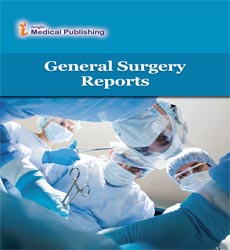Clinical Outcomes of Cataract Surgery
Koma Amosy*
Department of Ophthalmology, University College of Medicine, USA
- *Corresponding Author:
- Koma Amosy Department of Ophthalmology, University College of Medicine, USA, Email: amosy_koma308@gmail.com
Received Date: November 08, 2021; Accepted Date: November 22, 2021; Published Date: November 29, 2021
Citation: Amosy K (2021) Clinical Outcomes of Cataract Surgery. Gen Surg Rep Vol.5 No.2:2.
Introduction
A cataract is the main source of visual impairment all around the world and medical procedure is the main known measure to manage it actually. Giving top notch waterfall careful administrations is basic assuming that patients with waterfall are to have their sight re-established. A critical focal point of a medical procedure is the result of the system. In waterfall medical procedure this is estimated dominatingly, utilizing visual sharpness. Populace and emergency clinic based investigations have uncovered that the visual result of waterfall medical procedure in many low and centre pay settings is habitually imperfect, frequently neglecting to arrive at the suggested guidelines set by the World Health Organization (WHO). One more approach to estimating result of waterfall medical procedure is to ask patients for their perspectives on whether medical procedure has changed the working of their eyes and their personal satisfaction. There are various devices accessible to catch patient perspectives and presently, these patient-detailed results are turning out to be all the more generally utilized. This paper examines the visual result of waterfall medical procedure and casings the result of a medical procedure inside the setting of the careful assistance, recommending that the interaction and result of care can't be isolated. It likewise examines the parts of patient-revealed result instruments and depicts a few accessible devices in more detail. At last, it portrays an ordered progression of provokes that should be tended to before an excellent waterfall careful assistance can be accomplished.
Intraocular collier focal points (ICLs) are backing chamber phasic focal points that give a refractive medical procedure choice to those with high near sightedness or astigmatism. The present moment and midterm results show great refraction strength, viability, and wellbeing. Waterfall has been proposed to be a significant long haul complexity of ICL implantation.
The momentary clinical results of waterfall extraction (inside the setting of laid out microsurgical practice) for an example of all patients going through waterfall medical procedure in the United Kingdom in 1990 are introduced. Change in best revised Snellen visual sharpness 3 months after medical procedure and the event of carefully related confusions were taken as clinical marks of result. In general 80% (n=764) of patients accomplished a best amended postoperative visual sharpness of 6/12 or better at 90 days. Precisely related entanglements happened in 7% (n=71) of all patients in the intra-usable period, in 22% (n=224) in the prompt post-employable time frame, in 18% (n=176) at the principal post-usable out-patient appraisal and in 20% (n=200) of patients at 90 days after medical procedure. Existing together visual pathology was distinguished as a danger factor for both poor visual result and the event of complexities. Expanding seriousness of visual pathology was related with expanded danger of helpless result. These outcomes address the principal public figures for the transient clinical results of waterfall medical procedure regarding the momentum careful practice in the United Kingdom.
This study gives a delegate appraisal of the administration of waterfall in the New Zealand public medical clinic framework. A dominatingly old, female populace, often displaying critical foundational sickness and existing together visual illness, moderately progressed waterfalls, and poor BSCVA, introduced for waterfall medical procedure. Most of subjects went through little entry point, phacoemulsification, day case a medical procedure. While practically 90% accomplished something like 6/12 BSCVA post-medical procedure, roughly 5% supported an antagonistic intraoperative occasion and 1.5% of eyes displayed a decrease in BSCVA postoperatively.
Acknowledgement
None.
Conflicts of Interest
The author declares that there is no conflicts of interest.
Open Access Journals
- Aquaculture & Veterinary Science
- Chemistry & Chemical Sciences
- Clinical Sciences
- Engineering
- General Science
- Genetics & Molecular Biology
- Health Care & Nursing
- Immunology & Microbiology
- Materials Science
- Mathematics & Physics
- Medical Sciences
- Neurology & Psychiatry
- Oncology & Cancer Science
- Pharmaceutical Sciences
